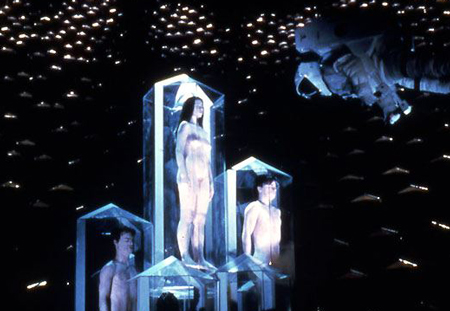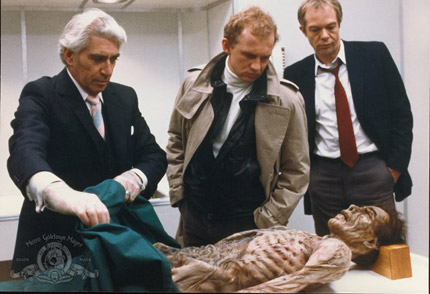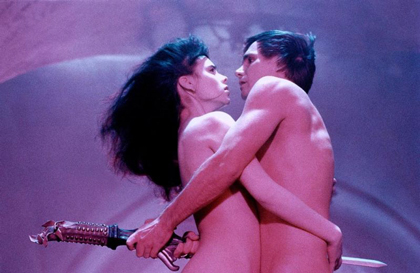
 |
|
|
|
In 1984 Menahem Golan and Yoram Globus kicked their production company Cannon Films upstairs into the big leagues, inking showy deals at Cannes. No more Breakin' and Electric Boogaloo; the high pressure team of Mo and Yo initiated projects with stars like Sally Fields and Julie Andrews, imported Russian director Andrei Konchalovsky and even took on a Superman sequel with Christopher Reeve. Menachem Golan was a science fiction fan determined to get in on the Star Wars action. One of Cannon's most expensive productions was directed by Tobe Hooper, a noted name in horror fresh from the Steven Spielberg hit Poltergeist. Golan chose an exciting novel by the respected science fiction author Colin Wilson, whose prose often incorporated interesting philosophical ideas. Wilson's title The Space Vampires underwent a change on the way to the screen, to Lifeforce. Under any name, Hooper's big-budget concoction is an out-of-control juggernaut of trashy horror, derivative sci-fi, entertainingly strange performances and eye-popping special effects. An exploratory spaceship commanded by American Colonel Tom Carlsen (Steve Railsback) discovers an apparently inert alien craft within the dust tail of Halley's Comet. They retrieve the preserved bodies of three perfect human specimens, two males and a female (Mathilda May). When radio communication is lost, a rescue mission finds all of the astronauts dead and the ship gutted by fire. But a week later commander Carlsen shows up no worse for wear in an escape capsule. By that time the alien bodies have arrived for study at London's Eurospace headquarters, where they come to life, violently. Capable of blasting through doors and windows and able to mesmerize people in their immediate vicinity, the three aliens only look like people. They're really space vampires, come to drain humans of a living "life force" essence that materializes as a blue electrical discharge. Their victims likewise turn into zombie-like vampire predators. Meanwhile, the enormous alien spaceship positions itself high above London. With the original space vampiress serving as the conduit, the spaceship prepares to harvest huge quantities of humanity's life force as it rises skyward in a beacon-like flow. 
Nobody can claim that Lifeforce isn't eventful. The storyline rockets through a swift succession of scenes, never pausing to establish anything like a consistent tone. The outer space adventure is just an eye-candy prologue for a monsters-run-amuck story down in a slightly futuristic England. The film's visual effects are initially so arresting that it's difficult to concentrate on the story. Cannon hired the best English facilities with some of the best camera talent available, giving the show a remarkable polish. Alan Hume's cinematography (blown up to 70mm for some engagements) is first-rate. The visuals of space travel, the mysterious comet and the wicked blasts of life-reaping alien energy are the work of American effects expert John Dykstra, who helped perfect the motion control technology that made Star Wars possible. Overseen by production designer John Graysmark, the gothic-futuristic visions of Lifeforce predict today's ubiquitous graphic-novel "dark" look. But Lifeforce doesn't know when to quit. It's overly complicated, unwieldy and unrestrained, a sober space epic one minute and a gross-out horror spectacle the next. Victims shrivel into desiccated pop-eyed mummies in a matter of seconds, as blue sparks shoot out of their eyes and mouths. These garish and goofy effects are like something from an old William Gaines horror comic. Bodies explode and a zombie blasts himself into dust by leaping at a wire mesh wall. A battery of good English actors enthusiastically embraces the bizarre goings-on. Cult actor Michael Gothard may or may not be possessed by the space vampiress, who leaves him alive but drained of energy. The face of Doctor Fellada (Frank Finlay) begins to bubble like frying bacon as he feels his life force preparing to desert him. Terrified MP Sir Percy Heseltine (Aubrey Morris of A Clockwork Orange) stares bug-eyed at one fearful sight after another. Possessed asylum governor Dr. Armstrong (a vibrant, go-for-broke Patrick Stewart) gushes forth a grisly torrent of blood and innards, which condense into a spectral image of the space vampiress. The best of these visual assaults defy immediate classification. 
Unfortunately, the credibility of Lifeforce vanishes with the entrance of the element that has made it a must-see item for young male sci fi fans. Mathilda May's space vampiress plays at least ten minutes of the film totally nude, resting in her casket like Sleeping Beauty and gliding through hallways of Eurospace's research facility. Audiences invariably laughed at this spectacle, if only to release the tension of decades of conditioning that says movies can't have scenes like this. Ms. May, a French dancer who moves with impeccable grace, embodies her alien role in the proper spirit. Yet the script uses the situation for some sniggering jokes from security guards, etc., who subsequently find themselves pulverized or life force- drained. The problem should have been obvious to Hooper -- the nude vampiress introduces a different level of 'audience participation' that stops the narrative cold. From that point forward Lifeforce no longer has a chance of being taken seriously. Two young boys that witness the vampiress slaying a woman in a park would seem to represent the movie's juvenile target audience. Even standing over the victim's shriveled corpse, one of them sniggeringly admits that he and his pal drew close to because it was two women, and they wanted to see if they were going to have sex. Did Menhahem Golan foresee a raunchy comedy sequel to Lifeforce that would star his Israeli Lemon Popsicle teens? The actors struggle valiantly to keep the show on the rails. Steve Railsback's astronaut Carlsen and a military intelligence officer, Colonel Colin Caine (Peter Firth) share hero duties. The capable Firth, late of Equus and Roman Polanski's Tess, is the movie's only 'normal' protagonist. He must solve the vampire mysteries while simultaneously figuring out Carlsen's ambivalent role in the alien invasion. The astronaut's mental visions help trace the alien as it jumps from one human host to another. Is Carlsen abetting the space vampiress? She spared his life on the ship, and they share some kind of psychic connection. Railsback certainly had an appropriately oddball résumé for the role, having made a splash as Charles Manson in a popular TV movie and scoring a success in the well-reviewed The Stunt Man. Unfortunately, Railsback's twisted brand of charisma gives us a hero stranger than the movie's monsters. Whether the blame belongs with the script or Railsback, he never seems stable enough to command a space mission. The film reaches a ludicrous low when Col. Carlsen needs information from the sexy, defiant mental patient Ellen (Nancy Paul), who he believes is possessed by an alien spirit. Carlsen pulls wildly at Ellen's clothes and pummels her with his fist: "This woman is a masochist! She wants me to beat the information out of her!" In theatrical screenings the rank incompetence of this moment was met with a wave of derisive laughter, making Lifeforce D.O.A. as a serious science fiction thriller. 
That's a shame, as the apocalyptic spectacle that finishes the film reaches a peak of horrific excitement. Having solved the mystery, Carlsen and Caine must traverse a burning, rioting London overrun with the hellish vampire plague. The horde of ghoulish creatures is itself laid waste by an alien life force ray, an energy tentacle that sweeps through the streets sucking up human essence like a cosmic vacuum cleaner. The only philosophical argument put forward in Lifeforce comes from Frank Finlay's Dr. Fellada: all life is vampiric in that it feeds in some way on other living things. The storyline shaped by Dan O'Bannon and Don Jakoby forgoes introspection to instead concoct an enormous, unwieldy stew of horror and science fiction elements. If Colin Wilson's 1976 novel is anything like the movie, it owes a huge debt to author Nigel Kneale's celebrated teleplay Quatermass and the Pit. In that story, man owes its history as an intelligent species to the intervention, ages ago, of insect-like Martians. The alien invasion failed but their influence is felt in our 'species memory'. Their long buried ships and artifacts still generate occult and psychic phenomena, reinforcing myths of devils and demons. In Lifeforce, the space vampires also visited Earth long ago, leaving us with a real source for the common human myth of vampire monsters. Lifeforce plays like Quatermass and the Pit enhanced with extravagant effects work. In both films the supernatural-psychic holocaust that lays waste to London can only be stopped by interrupting the proceedings with a symbolic "grounding" of evil energy. Lifeforce's alien ship reminds us of "colossal space wedgies" in everything from the Arthur C. Clarke novel Rendezvous with Rama to the robot in Kurt Neumann's Kronos, which incidentally collects the Earth's energy resources by generating similar electrical storms. The show tosses in everything from an Arthurian mystic sword to a possession motif somewhere between Invasion of the Body Snatchers and The Exorcist. To be fair to both Nigel Kneale and Colin Wilson, it's occasionally difficult to say who is borrowing from whom. The 1980 British TV serial Quatermass (The Quatermass Conclusion) debuted after The Space Vampires but may have been written before. It features a similar 'space beacon' at Stonehenge that attracts a pilgrimage of the world's youth, for the exact same purpose of harvesting human life force, and projecting it into space. Star Trek: The Motion Picture ends just as does Lifeforce, with two lovers joined in a cosmic embrace and surrounded by a psychedelic aura. Were all of these similar story elements coincidental? 
The middle 1980s saw a boom in science fiction spectacles. The shrewdly budgeted sleepers The Terminator and RoboCop launched James Cameron and Paul Verhoeven on even more expensive futuristic adventure thrillers. But Lifeforce and David Lynch's spectacularDune didn't set the mass audience afire. Tobe Hooper's follow-up for Cannon was a wholly unnecessary remake of the classic Invaders of Mars, that didn't even approach the appeal of the original. Hooper's third Cannon effort, made when the studio was drifting toward bankruptcy, returned him to horror territory -- The Texas Chainsaw Massacre 2. Scream Factory / MGM's Blu-ray + DVD Combo Pack presentation of Lifeforce knows that diehard fantasy fans have a secret love for this bizarre concoction, which came out long ago as a deficient non-enhanced MGM DVD. As if the collapse of extras-laden genre special editions had never occurred, Scream Factory has organized things perfectly. Audio tracks are provided in DTS and Dolby Digital 5.1. Fans will cheer composer Henry Mancini's title theme, which generates both spectacle and excitement. But Mancini's music never helps unify the movie's crazy quilt of moods. Could any music? The main theme returns when our heroes go into action to save the world, but the feeling of 'big adventure' seems suited for a different movie. With so many quality elements Lifeforce is a fun movie to revisit... even knowing that it isn't going to suddenly improve. The Blu-ray contains the 101-minute U.S. theatrical version and the more coherent (bonkers?) 116-minute international U.K. version, in identical visual quality. The long version was mastered first, and then edited to match the shorter; a couple of alternate angles used to maintain the continuity on the shorter version have been retained. A new opening eliminates Mancini's main theme and spreads the main titles over the prologue scene in outer space. The extras include trailers, a TV spot and a stills gallery. Cannon's original 1985 behind the scenes featurette shows some of the elaborate rigging and clever miniatures used to film the special effects. Tobe Hooper contributes a few interesting anecdotes and observations to the full-length feature commentary. But he must contend with a host that repeatedly interrupts him, burning up time with fannish gushing and personal opinions. Perhaps it is appropriate for the film's intended market, but the host also waxes prepubescent over the Mathilda May scenes, verbally elbowing Hooper with infantile remarks. Hooper tries his best to communicate Ms. May's enormous contribution to his movie, acknowledging that finding the right space vampiress was a miracle. Three new retrospective featurettes are based on interview input from the director and Steve Railsback. The classiest extra is a third interview piece with Mathilda May. Clear-eyed and proud of her role in the film, she shows not a glimmer of regret or insecurity. As a dancer she considers her body to be more or less a costume, something to work with. She comes off as a genuine artist-professional. The DVD disc included in the package contains only the longer international cut, but the same selection of extras.
On a scale of Excellent, Good, Fair, and Poor,
Lifeforce Blu-ray rates:
Reviews on the Savant main site have additional credits information and are often updated and annotated with footnotes, reader input and graphics.
Review Staff | About DVD Talk | Newsletter Subscribe | Join DVD Talk Forum |
| ||||||||||||||||||